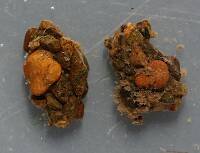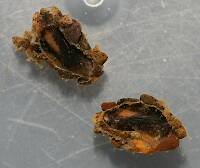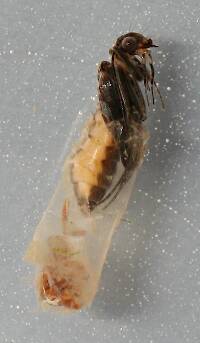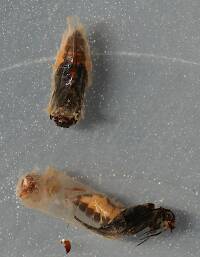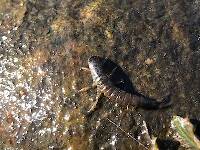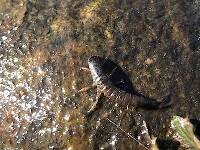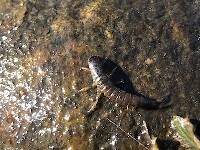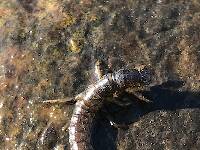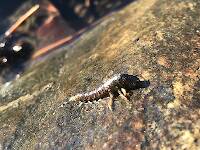
Blue-winged Olives
Baetis
Tiny Baetis mayflies are perhaps the most commonly encountered and imitated by anglers on all American trout streams due to their great abundance, widespread distribution, and trout-friendly emergence habits.
Featured on the forum


Troutnut is a project started in 2003 by salmonid ecologist Jason "Troutnut" Neuswanger to help anglers and
fly tyers unabashedly embrace the entomological side of the sport. Learn more about Troutnut or
support the project for an enhanced experience here.
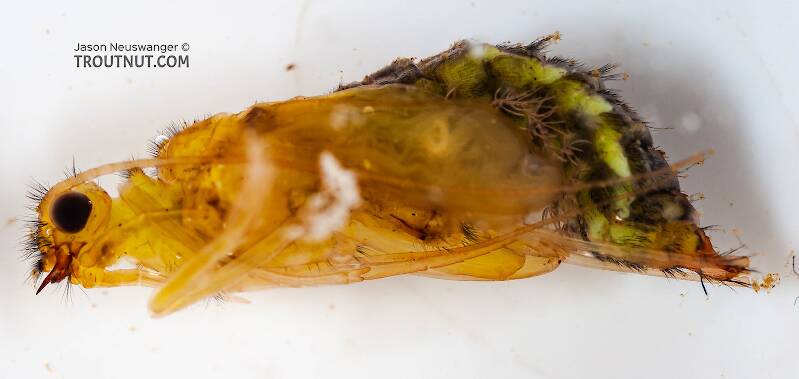
Several users have interesting comments in the discussion of this specimen, but this observation by Creno is especially good:
Also, this is what I would call an "immature" pupa. The wingpads of caddis pupae darken to nearly black as the enclosed adults near emerging. The darkening is the developing adult wing inside the pupal wing pad. The ultimate coloration of the adult wing is not very apparent in most pupal wing pads as the majority of the adult wing coloration comes from the color/position of the adult wing hairs and setae. But dark pupal wingpads are a good indication that the emergence will occur very soon, likely that day or so, and that the adult parts are sufficiently developed within the pupae to make a species determination from the specimen, particularly if it is a male.
GONZO on May 19, 2007May 19th, 2007, 6:47 am EDT
This actually looks more like a hydropsychid to me, probably one of the lighter-winged species of Cheumatopsyche. I hope we can get one of the experts to take a look.
Earlfishman
Posts: 17
Posts: 17
Earlfishman on May 19, 2007May 19th, 2007, 7:29 am EDT
I agree with Gonzo that it is a Hydropsychid, not a Brachycentrid based on its gills and the shape of the end of its body with those long hairs.
Based on the pictures and the only key I have access to, I would guess that it is Hydropsyche sp. rather than Cheumatopsyche sp. because the rear hook plates on the third abdominal segment seem more linear than oval. I can't see quite well enough to be 100% sure though.
Earl
Based on the pictures and the only key I have access to, I would guess that it is Hydropsyche sp. rather than Cheumatopsyche sp. because the rear hook plates on the third abdominal segment seem more linear than oval. I can't see quite well enough to be 100% sure though.
Earl
GONZO on May 19, 2007May 19th, 2007, 7:51 am EDT
Thanks, Earl. I was basing the Cheumatopsyche guess on Lito's earlier comment (on another specimen) that the hooks on the end of the abdomen are longer distally in that genus. If it is Hydropsyche, it might be the pupa of the adult (see "Can I get a better ID on this?") captured nearby two days later, but that particular character seems reversed on that specimen. (And I think that specimen probably is Hydropsyche or Ceratopsyche.) What do you think?
Earlfishman
Posts: 17
Posts: 17
Earlfishman on May 19, 2007May 19th, 2007, 8:38 am EDT
Gonzo,
My determination of Hydropsyche sp. instead of Cheumatopsyche sp. is at least a little bit of a guess as well. I can never quite convince myself without being able to look at the actual bug instead of pictures, and even then I am frequently content to leave caddis pupae at family. I went looking for a key after Lito took that other pupae to genus, and although I found what seems to be a good one, at this point I'm still not completely sure of anything beyond family.
As far as the adult that you asked about goes, I must confess that my knowledge of adult taxonomy is pretty limited and relies heavily on circumstantial associations. Usually when looking at adults I am far from a microscope and am content to take off my bugging hat, put on a fishing hat, call it a size 14, dark-bodied, dark-winged elk-hair or Hemingway caddis, and just go fishing.
I would expect that many of the features used to distinguish pupae don't carry over to adults and that many probably do, but I wouldn't hazard a guess as to which do and don't.
Hopefully someone else knows a lot more about adults than I do and can enlighten both of us. I know I'd like to learn something.
Earl
My determination of Hydropsyche sp. instead of Cheumatopsyche sp. is at least a little bit of a guess as well. I can never quite convince myself without being able to look at the actual bug instead of pictures, and even then I am frequently content to leave caddis pupae at family. I went looking for a key after Lito took that other pupae to genus, and although I found what seems to be a good one, at this point I'm still not completely sure of anything beyond family.
As far as the adult that you asked about goes, I must confess that my knowledge of adult taxonomy is pretty limited and relies heavily on circumstantial associations. Usually when looking at adults I am far from a microscope and am content to take off my bugging hat, put on a fishing hat, call it a size 14, dark-bodied, dark-winged elk-hair or Hemingway caddis, and just go fishing.
I would expect that many of the features used to distinguish pupae don't carry over to adults and that many probably do, but I wouldn't hazard a guess as to which do and don't.
Hopefully someone else knows a lot more about adults than I do and can enlighten both of us. I know I'd like to learn something.
Earl
GONZO on May 19, 2007May 19th, 2007, 8:49 am EDT
I know I'd like to learn something.
Thanks, Earl. Me too!
Litobrancha on May 19, 2007May 19th, 2007, 6:50 pm EDT
maxillary palps look hydropychid-ish, as well as anal processes. a good dorsal and possibly lateral view would help that a bit, but i agree with others it looks like cheumatopsyche.
Creno on Jun 21, 2008June 21st, 2008, 5:00 am EDT
This appears to be a Hydropsyche pupa, not Cheumatopsyche. The most obvious pupal character used to separate these to genera is the shape of the posterior dorsal hook plate of the third abdominal segment. The posterior hook plate is linear in Hydropsyche (and clearly evident in the 2nd photo) while more oval in Cheumatopsyche. If you have access to Ross 1944, The Caddis Flies, or Trichoptera of Illinois, there is a good illustration of the difference. I suspect the photo was taken specifically so the shape of the hook plate could be clearly seen. Well done.
Also, this is what I would call an "immature" pupa. The wingpads of caddis pupae darken to nearly black as the enclosed adults near emerging. The darkening is the developing adult wing inside the pupal wing pad. The ultimate coloration of the adult wing is not very apparent in most pupal wing pads as the majority of the adult wing coloration comes from the color/position of the adult wing hairs and setae. But dark pupal wingpads are a good indication that the emergence will occur very soon, likely that day or so, and that the adult parts are sufficiently developed within the pupae to make a species determination from the specimen, particularly if it is a male.
Also, this is what I would call an "immature" pupa. The wingpads of caddis pupae darken to nearly black as the enclosed adults near emerging. The darkening is the developing adult wing inside the pupal wing pad. The ultimate coloration of the adult wing is not very apparent in most pupal wing pads as the majority of the adult wing coloration comes from the color/position of the adult wing hairs and setae. But dark pupal wingpads are a good indication that the emergence will occur very soon, likely that day or so, and that the adult parts are sufficiently developed within the pupae to make a species determination from the specimen, particularly if it is a male.
GONZO on Jun 21, 2008June 21st, 2008, 7:06 am EDT
Dave,
Thank you for adding your expertise to the guesswork/discussion. Your comments raise questions that are both interesting and practical. I had always assumed that the time from when the pupa escaped the pupation enclosure to when it emerged as an adult was very brief. You seem to be suggesting that it might be much longer, perhaps a day or more. Is there some "average" time? Does it vary significantly with species/conditions? And how do the little buggers occupy their time prior to emerging?
Thank you for adding your expertise to the guesswork/discussion. Your comments raise questions that are both interesting and practical. I had always assumed that the time from when the pupa escaped the pupation enclosure to when it emerged as an adult was very brief. You seem to be suggesting that it might be much longer, perhaps a day or more. Is there some "average" time? Does it vary significantly with species/conditions? And how do the little buggers occupy their time prior to emerging?
Creno on Jun 21, 2008June 21st, 2008, 8:28 am EDT
Perhaps my understanding of the term "pupae" is different than yours. I use pupae as the "inactive" stage between the larvae and adult of holometabolous insects. In caddis the pupal stage lasts longer than the period of its life between the case (pupal enclosure or puparium) and the emergence (eclosure)of the pharate adult from the pupal skin. The length of pupal existance varies from species to species and with temperature but is probably 2-3 weeks in trout streams. You are right that the period of pupal life between the case and the adult emergence is very short, probably measured more in terms of minutes than in hours.
I strongly suspect the photos we are looking at are of a pupae that was removed from the case. That is why the developing adult wings have not darkened yet. I don't believe a caddis pupae would voluntarily leave its case in the state of development the pictures show.
What they are doing for the weeks/months that the case is closed is a fascinating topic - but perhaps not for all folks. Some species (mostly limnephiloids) have a long larval resting period where they just seem to sit there doing little of anything. This resting period is thought to be a strategy used to avoid bad times and/or adjust variable larval growth rates to assure coincident adult emergence. Once any resting period is completed they go through massive cellular changes as they change from larvae to pupae to pharate adult within the typical 2-3 week "pupal" period. If you open a case during these cellular transformations you literally find mush as the material rearranges itself from larval legs, to pupal legs, to adult legs, etc.
Then the minutes or so of the pupal life is the period the fisherman sees in the drift or along the shore after the pupae leaves the puparium and the pharate adult emerges from the pupal skin.
hope this helps
I strongly suspect the photos we are looking at are of a pupae that was removed from the case. That is why the developing adult wings have not darkened yet. I don't believe a caddis pupae would voluntarily leave its case in the state of development the pictures show.
What they are doing for the weeks/months that the case is closed is a fascinating topic - but perhaps not for all folks. Some species (mostly limnephiloids) have a long larval resting period where they just seem to sit there doing little of anything. This resting period is thought to be a strategy used to avoid bad times and/or adjust variable larval growth rates to assure coincident adult emergence. Once any resting period is completed they go through massive cellular changes as they change from larvae to pupae to pharate adult within the typical 2-3 week "pupal" period. If you open a case during these cellular transformations you literally find mush as the material rearranges itself from larval legs, to pupal legs, to adult legs, etc.
Then the minutes or so of the pupal life is the period the fisherman sees in the drift or along the shore after the pupae leaves the puparium and the pharate adult emerges from the pupal skin.
hope this helps
GONZO on Jun 21, 2008June 21st, 2008, 10:38 am EDT
Thanks for the clarification, Dave. Although my questions were about the pharate adult after it exits the enclosure, I didn't realize that you were referring to development (such as the darkening of wingpads) prior to that. Jason did not mention removing this specimen from the pupal enclosure (as he sometimes does). If I understand what you are saying, a trout would rarely, if ever, see a "pupa" prior to the darkening of the wingpads. Is that correct?
Creno on Jun 21, 2008June 21st, 2008, 2:00 pm EDT
sorry for the confusion. I went back though the reply trail and I think the basic problem (my reply) was because of a possible typo. It seems like the discussion went to Hydropsyche based on the same character I used - Earlfishman. Somehow that was converted to Cheumatopsyche although Litobrancha agreed with previous replies, and the page title shows Cheumatopsyche. So I unfortunately just looked at the photos and replied to that last reply.
Yes, I think a trout will normally see a pupae with the black wingspads of a nearly fully developed adult inside. I have seen alot of drift samples and never seen a pupae without dark wing pads. And I have opened alot more puparia looking for those dark wingpads. There are alot of them still in there. But I am not able to send you to independent citations that support that observation. Taxon, do know of any one way or another?
That's not to say a pupae wouldn't get into the water column with less than black wingpads like the photo but I don't think that would be the choice of the pupae.
Yes, I think a trout will normally see a pupae with the black wingspads of a nearly fully developed adult inside. I have seen alot of drift samples and never seen a pupae without dark wing pads. And I have opened alot more puparia looking for those dark wingpads. There are alot of them still in there. But I am not able to send you to independent citations that support that observation. Taxon, do know of any one way or another?
That's not to say a pupae wouldn't get into the water column with less than black wingpads like the photo but I don't think that would be the choice of the pupae.
GONZO on Jun 21, 2008June 21st, 2008, 3:25 pm EDT
Not a problem, Dave, and thanks again. I think you'll find that there are a number of specimens where the discussion eventually led to a better or more definitive ID, but I don't think Jason has had the time to go back and sort it all out yet. There are other tentative specimen IDs that are just hanging in the ether, awaiting an expert's confirmation or correction, and still others that may never get much beyond family. So, any help you can provide is very much appreciated.
LittleJ on May 6, 2009May 6th, 2009, 2:35 pm EDT
I just want to bump this up with a couple more questions on these guys.
1-with the exception of darkening wingpads would the color of these pupa be consistent w/ the specimen shown, upon emerging from it's pupal shelter?
2- How long typically do the pupa "drift" around in the time between pupal shelter & adult?
3- how long does it stay in the pupal shelter prior to emerging
Feel free to answer any/all/none or just point me in a direction to get the answers.
thanks
jeff
1-with the exception of darkening wingpads would the color of these pupa be consistent w/ the specimen shown, upon emerging from it's pupal shelter?
2- How long typically do the pupa "drift" around in the time between pupal shelter & adult?
3- how long does it stay in the pupal shelter prior to emerging
Feel free to answer any/all/none or just point me in a direction to get the answers.
thanks
jeff
GONZO on May 6, 2009May 6th, 2009, 5:39 pm EDT
Jeff,
1. Body color will vary with species (and sometimes gender), but shades of olive, yellow, and tan will probably cover most bases for the common Hydropsyche/Ceratopsyche pupae.
Creno addressed your last two questions in the discussion above:
2.
3.
1. Body color will vary with species (and sometimes gender), but shades of olive, yellow, and tan will probably cover most bases for the common Hydropsyche/Ceratopsyche pupae.
Creno addressed your last two questions in the discussion above:
2.
...the period of pupal life between the case and the adult emergence is very short, probably more in terms of minutes than in hours.
3.
The length of pupal existance varies from species to species and with temperature but is probably 2-3 weeks in trout streams.
LittleJ on May 7, 2009May 7th, 2009, 8:26 am EDT
Thanks gonzo, I must have had an ADD flair up because I read that post twice before I posted my questions:)
Quick Reply
Related Discussions
Topic
Replies
Last Reply
Re: Here's two I could use some help with from East Tennessee! 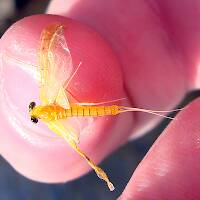
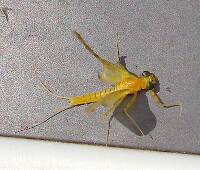
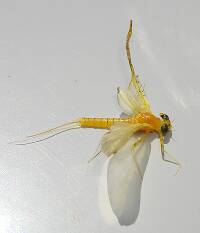
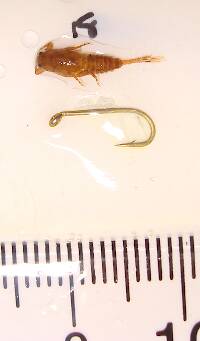
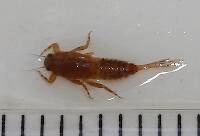
In the Identify This! Board by BrettHRomer
+ 1





In the Identify This! Board by BrettHRomer
6
May 8, 2008
by JOHNW
by JOHNW
8
Jun 5, 2007
by Dinerobyn
by Dinerobyn
0
Mar 23, 2010
by Troutboomer
by Troutboomer
0
Sep 23, 2006
by Litobrancha
by Litobrancha


